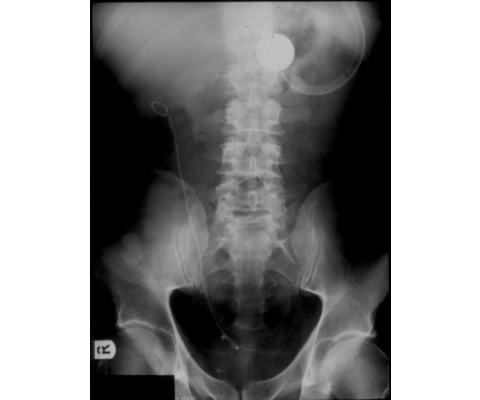Procedure
Click on the links below.
Percutaneous antegrade ureteric stent insertion is a useful technique in the treatment of long standing benign and malignant ureteric strictures. It is minimally invasive, avoids need for general anaesthetic and may be possible where retrograde stent insertion has failed. It is preferable to nephrostomy in the long term relief of obstruction.
The access technique is the same as that for balloon dilatation. Following this, a JJ ureteric stent is placed (Fig 1). The distal pigtail is formed within the bladder, the proximal pigtail within the renal pelvis.
Click on the Aftercare tab at the top for more information, or Next to move on to a different procedure.

Image reproduced with permission from Dr Ian Francis
Indications
- Malignant strictures (by far the most common)
- Benign strictures (e.g. retroperitoneal fibrosis)
- Obstructive ureteric calculus
- Adjunct to extracorporeal shockwave lithotripsy
- Ureteric injury (traumatic or iatrogenic)
Contraindications
Absolute: None
Relative:
- Acute or uncontrolled urinary tract sepsis
- Untreated coagulopathy
Patient preparation
Patient preparation is as for other renal procedures:
- Consent
- Bloods: FBC, U&E, clotting
- Hb>9
- INR 0.8–1.4
- Plt>50
- IV access and rehydrate if necessary
- Anticoagulation drugs stopped
- NBM 4-6 hours prior to procedure
Aftercare
Complications can include:
- Irritative bladder symptoms
- Supra-pubic and loin pain
- Haematuria
- Urinary tract infection
- Malposition/migration of the stent or inability to cross a tight malignant stricture
- Occlusion and repeat procedure. Patency rate at 3 months is 95%; at 6 months 54%
Question: Based on the patency information given above, what aftercare and follow-up would you recommend?
Click here for the answer.

Complications can include:
- Irritative bladder symptoms
- Supra-pubic and loin pain
- Haematuria
- Urinary tract infection
- Malposition/migration of the stent or inability to cross a tight malignant stricture
- Occlusion and repeat procedure. Patency rate at 3 months is 95%; at 6 months 54%
Question: Based on the patency information given above, what aftercare and follow-up would you recommend?
Answer:
A percutaneous nephrostomy is left in situ, but can usually be removed after 24 hours.
Periodic ultrasound and renal function tests are required and replacement is advised every 3-4 months. Once an antegrade stent has been positioned, replacement stents can usually be introduced via a retrograde route (cystoscopy).
